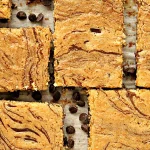Plain butter croissants always remind me of cozy mornings, especially when the smell of freshly baked pastry fills the house. There’s something truly magical about that golden, flaky goodness.
They’re perfect for a relaxed weekend breakfast, a delightful brunch, or even as a special treat with your afternoon coffee or tea. What makes these croissants special is their simplicity – just pure, buttery layers that melt in your mouth.
Recipe Overview: Classic Butter Croissants
This recipe is all about creating those classic, plain butter croissants that you find in a Parisian bakery. We’re focusing on achieving a light, airy interior and a crispy, golden-brown exterior.
The key is the laminated dough, which means we’ll be folding butter into the dough multiple times to create those distinct layers. It sounds fancy, but it’s totally doable at home.
These croissants are amazing on their own, warm from the oven. But feel free to serve them with your favorite jam, a bit of honey, or even alongside some fresh fruit and cheese. They’re versatile like that!
The process can take a little time, but the aroma while baking and the first bite are incredibly rewarding. You’ll feel like a professional baker.
Detailed Ingredients for Perfect Croissants
Here’s what you’ll need to make these delicious pastries:
- All-purpose flour (500g): This provides the structure for our dough. You can also use bread flour for a slightly chewier croissant, but all-purpose works great.
- Instant dry yeast (7g, or one packet): This is what makes our croissants rise and become light and airy. Make sure your yeast is fresh!
- Sugar (50g): Just a touch of sweetness to balance the butter and help feed the yeast.
- Salt (10g): Enhances the flavor and controls the yeast activity.
- Milk (125ml), lukewarm: The liquid helps activate the yeast and brings the dough together. Make sure it’s not too hot, or it could kill the yeast.
- Water (125ml), lukewarm: Adds to the hydration of the dough.
- Unsalted butter (250g), cold: This is the star of the show! The cold butter creates those beautiful, flaky layers. Unsalted is best so you can control the saltiness. I recommend using a good-quality butter for the best flavor.
- 1 Egg (for egg wash): This gives the croissants a beautiful golden sheen when baked.
If you don’t have instant yeast, you can use active dry yeast. Just be sure to activate it in the lukewarm milk and water mixture with a pinch of the sugar for about 5-10 minutes before adding it to the other ingredients.
Step-by-Step Instructions: Making Your Own Butter Croissants
- Make the Dough: In a large mixing bowl, whisk together the flour, yeast, sugar, and salt.
- Add the lukewarm milk and water. Mix until a shaggy dough forms.
- Turn the dough out onto a lightly floured surface and knead for about 5-7 minutes, until it becomes smooth and elastic.
- First Rise: Shape the dough into a ball, place it back in the bowl, and cover it with plastic wrap or a damp kitchen towel. Let it rise in a warm place for about 1-1.5 hours, or until doubled in size.
- Prepare the Butter Block: While the dough is rising, place the cold butter between two sheets of parchment paper. Using a rolling pin, pound and roll the butter into a 6×8 inch rectangle. Keep it chilled.
- Laminate the Dough (First Turn): Once the dough has doubled, punch it down to release the air. Roll it out into a 12×16 inch rectangle.
- Place the cold butter block in the center of the dough, leaving a border around the edges.
- Fold the dough over the butter like a letter, enclosing the butter completely. Pinch the seams to seal.
- Roll and Fold (First Turn): Gently roll the dough out into a 24-inch-long rectangle. Be careful not to press too hard, or the butter might break through.
- Fold the dough in thirds, like a letter again. This is your first “turn.” Wrap the dough in plastic wrap and chill in the refrigerator for 30 minutes.
- Second and Third Turns: Repeat the rolling, folding, and chilling process two more times. Each time, rotate the dough 90 degrees before rolling. This ensures even layers. So, roll, fold, chill for 30 minutes, then repeat one last time.
- Final Chill: After the third turn, wrap the dough tightly and chill for at least 2 hours, or preferably overnight. This allows the gluten to relax and the butter to firm up, making it easier to shape.
- Shape the Croissants: On a lightly floured surface, roll the chilled dough out into a large rectangle, about 1/8 inch thick.
- Using a sharp knife or pizza cutter, trim the edges to make a clean rectangle.
- Cut the dough into triangles. Each triangle should be about 4-5 inches wide at the base.
- Roll the Croissants: Starting at the base of each triangle, gently stretch the dough, then roll it up towards the tip.
- Place the rolled croissants on a baking sheet lined with parchment paper, leaving some space between them. Curve the ends slightly to create a crescent shape.
- Final Proof: Cover the croissants loosely with plastic wrap and let them proof in a warm place for 1-2 hours, or until they are puffy and almost doubled in size.
- Egg Wash: Preheat your oven to 375°F (190°C). Gently brush the proofed croissants with the beaten egg.
- Bake: Bake for 18-22 minutes, or until the croissants are golden brown and cooked through. Rotate the baking sheet halfway through to ensure even browning.
- Cool: Let the croissants cool on a wire rack for a few minutes before serving. They are best enjoyed warm!
Variations & Tips for the Best Croissants
- Chocolate Croissants: Add a few small pieces of chocolate to the center of each triangle before rolling them up.
- Make-Ahead: You can prepare the dough through the final chill and keep it in the refrigerator for up to 2 days. Or, you can freeze the shaped, unproofed croissants for up to a month. Thaw them overnight in the refrigerator before proofing and baking.
- Storage: Store leftover croissants in an airtight container at room temperature for up to 2 days, or in the freezer for longer storage.
- Reheating: To reheat, warm the croissants in a preheated oven at 350°F (175°C) for 5-7 minutes, or until heated through.
- Serving: Serve plain butter croissants as part of a breakfast spread, with coffee or tea, or even with a savory filling for a light lunch.
Key Details
- Prep time: 45 minutes (plus rising and chilling time)
- Cook time: 18-22 minutes
- Total time: Approximately 4 hours (including rising and chilling)
- Servings: 12 croissants
- Equipment you’ll need: Mixing bowls, rolling pin, parchment paper, baking sheet, sharp knife or pizza cutter.

Plain Butter Croissant
Ingredients
- All-purpose flour 500g
- Instant dry yeast 7g, or one packet
- Sugar 50g
- Salt 10g
- Milk 125ml, lukewarm
- Water 125ml, lukewarm
- Unsalted butter 250g, cold
- 1 Egg for egg wash
Instructions
- Make the Dough: In a large mixing bowl, whisk together the flour, yeast, sugar, and salt.
- Add the lukewarm milk and water. Mix until a shaggy dough forms.
- Turn the dough out onto a lightly floured surface and knead for about 5-7 minutes, until it becomes smooth and elastic.
- First Rise: Shape the dough into a ball, place it back in the bowl, and cover it with plastic wrap or a damp kitchen towel. Let it rise in a warm place for about 1-1.5 hours, or until doubled in size.
- Prepare the Butter Block: While the dough is rising, place the cold butter between two sheets of parchment paper. Using a rolling pin, pound and roll the butter into a 6x8 inch rectangle. Keep it chilled.
- Laminate the Dough (First Turn): Once the dough has doubled, punch it down to release the air. Roll it out into a 12x16 inch rectangle.
- Place the cold butter block in the center of the dough, leaving a border around the edges.
- Fold the dough over the butter like a letter, enclosing the butter completely. Pinch the seams to seal.
- Roll and Fold (First Turn): Gently roll the dough out into a 24-inch-long rectangle. Be careful not to press too hard, or the butter might break through.
- Fold the dough in thirds, like a letter again. This is your first "turn." Wrap the dough in plastic wrap and chill in the refrigerator for 30 minutes.
- Second and Third Turns: Repeat the rolling, folding, and chilling process two more times. Each time, rotate the dough 90 degrees before rolling. This ensures even layers. So, roll, fold, chill for 30 minutes, then repeat one last time.
- Final Chill: After the third turn, wrap the dough tightly and chill for at least 2 hours, or preferably overnight. This allows the gluten to relax and the butter to firm up, making it easier to shape.
- Shape the Croissants: On a lightly floured surface, roll the chilled dough out into a large rectangle, about 1/8 inch thick.
- Using a sharp knife or pizza cutter, trim the edges to make a clean rectangle.
- Cut the dough into triangles. Each triangle should be about 4-5 inches wide at the base.
- Roll the Croissants: Starting at the base of each triangle, gently stretch the dough, then roll it up towards the tip.
- Place the rolled croissants on a baking sheet lined with parchment paper, leaving some space between them. Curve the ends slightly to create a crescent shape.
- Final Proof: Cover the croissants loosely with plastic wrap and let them proof in a warm place for 1-2 hours, or until they are puffy and almost doubled in size.
- Egg Wash: Preheat your oven to 375°F (190°C). Gently brush the proofed croissants with the beaten egg.
- Bake: Bake for 18-22 minutes, or until the croissants are golden brown and cooked through. Rotate the baking sheet halfway through to ensure even browning.
- Cool: Let the croissants cool on a wire rack for a few minutes before serving. They are best enjoyed warm!




